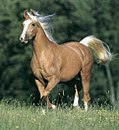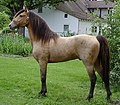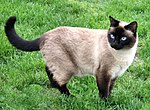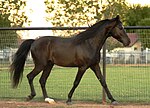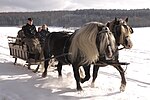Uses include: Flaxen, a variant of the blonde human hair color Flaxen gene, a gene that causes light-colored manes and tails in chestnut-colored horses...
646 bytes (115 words) - 15:28, 30 October 2023
Flaxen is a genetic trait in which the mane and tail of chestnut-colored horses are noticeably lighter than the body coat color, often a golden blonde...
6 KB (557 words) - 14:03, 23 February 2024
recessive mode of inheritance. Flaxen chestnut and blond chestnut are terms that describe manes and/or tails that are flaxen, or significantly lighter than...
17 KB (2,060 words) - 03:49, 8 March 2024
mane and tail. Chestnut with flaxen mane and tail: Lighter chestnuts with a light cream mane and tail carry a flaxen gene, but not a cream dilution. For...
20 KB (2,199 words) - 00:06, 2 April 2024
chocolate (rather than black) points. Flaxen chestnut vs. palomino: Horses having light chestnut coats with flaxen manes and tails, such as those found...
37 KB (4,679 words) - 00:20, 14 April 2024
Flax or Flaxen is a pale yellowish-gray, the color of straw or unspun dressed flax. The first recorded use of flax as a color name in English was in 1915...
1 KB (150 words) - 17:16, 13 March 2024
The dun gene is a dilution gene that affects both red and black pigments in the coat color of a horse. The dun gene lightens most of the body while leaving...
20 KB (2,643 words) - 05:52, 28 February 2024
of the Roan gene (Rn) on a chestnut base coat. The mutation responsible for all Roan coats, identified in 1999, is located on the KIT gene. This coat color...
34 KB (3,707 words) - 16:43, 1 May 2024
champagne gene is a simple dominant allele responsible for a number of rare horse coat colors. The most distinctive traits of horses with the champagne gene are...
40 KB (5,164 words) - 00:21, 14 April 2024
preferred "chocolate" coat color and flaxen mane and tail, the result of the relatively rare silver dapple gene acting on a black coat, seen in much of...
13 KB (1,576 words) - 20:46, 18 September 2023
Abnormalities. It will typically dilute a black mane and tail to a silvery gray or flaxen color, and a black body to a chocolaty brown, sometimes with dapples. It...
12 KB (1,488 words) - 16:05, 3 December 2023
Equine coat color (section Other dilution genes)
those surrounding spotting patterns, color sub-shades such as "sooty" or "flaxen", and markings. The two basic pigment colors of horse hairs are pheomelanin...
30 KB (4,230 words) - 00:13, 14 April 2024
Sooty horse (redirect from Sooty gene)
palominos. Sootiness is believed to be an inherited trait involving multiple genes, however the details are not yet known. Horses without any visible sooty...
8 KB (947 words) - 18:12, 24 March 2024
dilution gene is any one of a number of genes that act to create a lighter coat color in living creatures. There are many examples of such genes: Diluted...
7 KB (883 words) - 21:41, 20 May 2024
coloration is most often produced by the action of the agouti gene. It acts on the extension gene, when present, to suppress black color to all but the extremities...
14 KB (1,653 words) - 20:47, 1 March 2024
Pearl gene, also known as the "Barlink factor", is a dilution gene at the same locus as the cream gene, which somewhat resembles the cream gene and the...
5 KB (560 words) - 22:43, 31 March 2024
spotting gene (incorrectly called the piebald gene). The same pattern that applies to cats also applies to dogs when the white spotting gene involved...
11 KB (1,198 words) - 17:57, 23 March 2024
century. Haflinger horses are relatively small, are always chestnut with flaxen mane and tail, have distinctive gaits described as energetic but smooth...
46 KB (5,573 words) - 01:27, 1 April 2024
Blond (redirect from Flaxen hair)
examples include the following: ash-blond: ashen or grayish blond. blond/flaxen: when distinguished from other varieties, "blond" by itself refers to a...
84 KB (8,305 words) - 23:20, 20 May 2024
Tiger eye or goat eye is a gene causing diluted eye color in horses. There are two variants, Tiger-eye 1 (TE1) and Tiger-eye 2 (TE2), which are both recessive...
6 KB (738 words) - 02:26, 1 December 2023
Bay (horse) (section Effect of gray gene)
dominant Agouti gene and at least one dominant Extension gene. While the basic genetics that create bay coloring are fairly simple, the genes themselves and...
20 KB (2,507 words) - 16:53, 12 May 2024
and ticking can occur on any brindle dog. Brindle is caused by a complex gene process and is technically a form of mosaicism, where some cells express...
11 KB (1,326 words) - 10:09, 14 March 2024
with the head mostly dark. Three less common spotting genes are the frame and splash overo genes, which create a mostly dark, jagged spotting with a horizontal...
4 KB (504 words) - 20:26, 2 January 2021
Smoky black is produced by the action of a heterozygous (single copy) cream gene on an underlying black coat color. Therefore, smoky black is a member of...
10 KB (1,426 words) - 21:06, 12 March 2024
surrounded by a dark "frame" of color. If two horses with the frame overo gene are bred together, there is a 25% chance the foal will have lethal white...
15 KB (1,806 words) - 00:12, 14 April 2024
Tiret, Laurent (2015). "A missense mutation in the agouti signaling protein gene (ASIP) is associated with the no light points coat phenotype in donkeys"...
5 KB (478 words) - 21:01, 30 March 2024
white" horses, especially those that carry one of the dominant white (W) genes, are rare. Most horses that are commonly referred to as "white" are actually...
29 KB (3,551 words) - 10:49, 3 November 2023
Leopard complex (redirect from Leopard gene)
sclera around the eye, striped hooves and mottled skin. The leopard complex gene is also linked to abnormalities in the eyes and vision. These patterns are...
24 KB (2,603 words) - 01:18, 10 January 2024
University of California. Retrieved 2008-06-04. Behning, Laura. "Rabicano, Roan, Flaxen, and Frame Overo Morgan Horses". Morgan Colors. Archived from the original...
11 KB (1,230 words) - 23:01, 31 March 2024
selection for flaxen chestnut coloring began in 1875. In a study of 250 horses of the breed published in 2013, two were found to carry silver genes, but because...
9 KB (803 words) - 00:35, 14 November 2023




